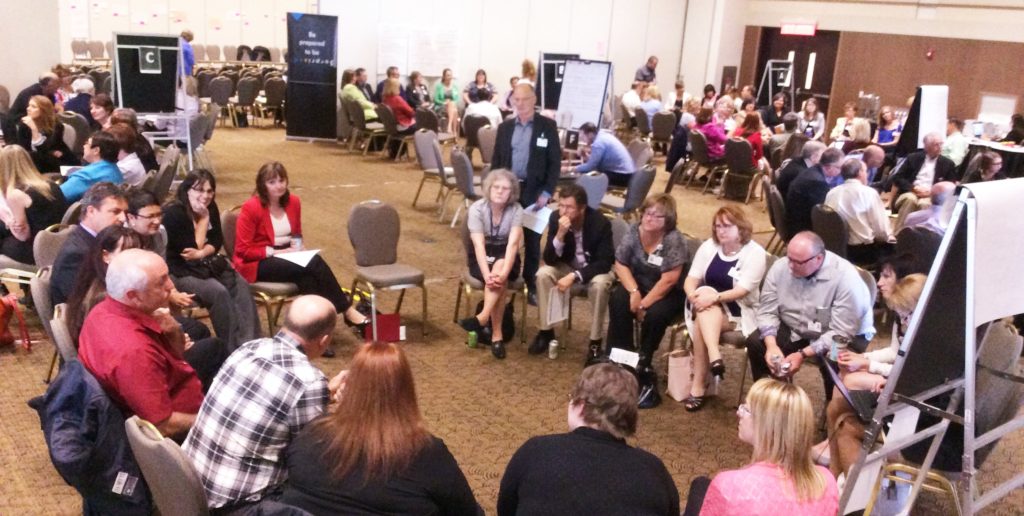Innovation processes: 5 principles
So “something’s not working”… and that ‘something’ is between us and where we want to be. We need something different. Something new. A new idea that works. An innovation.
How does one go about getting an innovation?

What can we do to find that new idea that works? Standing on an innovation and looking back, we see there are a variety of ways we can get there. A spark of imagination. A dream. A systematic cross-pollination of options followed by a rigorous review, prototyping, evaluation, piloting and selection process for the best idea. Shutting a group of young designers in a room with coffee and not letting them out until they come up with something.
With limited resources, which is your best path forward?
Here are some basic principles we use to design a process that evokes innovative thinking:
-
Get the right people in the room.
To turn an adage on its head, if you’re not part of the problem, you can’t be part of the solution. I have been part of many a consultation process that invited a relevant, yet incomplete, slice of those who have a stake in the issue. In particular, the ‘user’ of a potential service or product or systems shift is often overlooked. Whenever there are stakeholders missing from the table, the resulting solution is incomplete and will typically face resistance from those who were not involved, or not be implementable (not ‘work’) because it requires support and/or action from a particular person or group.
Objection: “It would be faster and easier with a smaller group”
Response: True in the short term, but here’s a wise proverb moment: If you want to go fast, go alone. If you want to go far, go together.
-
Get people into the right side of their brains.
Use just enough structure to provide constraints such that there is still a space that invites creativity. We can call these liberating structures. We often use a method based on Lego® Serious Play® to bring participants into a place of flow and out of their thinking minds into a place of purposeful creativity.
Objection: “This group is serious about getting things done. They won’t want to waste time ‘playing’.”
Response: Actually all adults like to play when it has a meaningful and relevant purpose. As Plato said, you can learn more about a person in an hour of play than in a year of conversation. Our bodies hold a lot of information – when we can include the wisdom of the body and heart with the wisdom of the mind, we can access deeper levels of insight. We have used Lego® Serious Play® with executive teams in the federal government, large private sector companies, small to large non-profit organizations as well as a number of law enforcement agencies at the local and national level, and accomplished more work than typically expected for the time committed.
-
Isolate people in a space outside their usual environment.
The importance of this is routinely underestimated. Being outside of your usual environment typically elevates your focus on your surroundings and therefore helps you be present to what is going on right here, right now. Your nervous system is slightly more activated since it doesn’t know what to expect. This helps you to be in a state that is more agile than when you’re in your usual routine / habits / patterns.
Objection: “It’s easier and cheaper to just do it here”
Response: A one-day workshop for 10 people is 750 hours of employee time. In relation to that investment, the cost of a different location is typically much less significant. It is more expensive to have people only half mentally present, stepping in and out, or covering only half the ground.
-
Work on things that matter to people.
Meaning, pain and passion are the fuel and the drivers of innovation. Working on a question that doesn’t really matter to people typically won’t ignite anything new – the spark isn’t there. Sometimes we find that what we think is important, isn’t actually what matters.
Objection: “We need to address this particular issue, we don’t have time right now to work on other things.”
Response: If you can link your issue to what matters to people, you will get more energy and remove blocks to the problem.
-
Zoom out. Look at the system. It matters.
There are many ways to model or visualize a system:
- in 2 dimensions using systems mapping such as flow or causal loop diagrams, rich picture maps, icebergs, or social network analyses; or
- in 3 dimensions using 3D modelling tools such as Lego® or dynamic mapping.
Objection: “We all know what the problem is. This systems mapping is confusing and takes up too much time.”
Response: We often think we’re on the same page, but the majority of the time we see things slightly-to-very differently. Even if we have the same idea of the problem, the best solution will hinge on a shared understanding of the current reality of the system.
The process of building a model of the system together typically unearths unspoken assumptions, mental models and allows a convergence of perspectives in a group. Only when we see ‘what is’ without judgement, do we actually have the possibility to shift things to what could be.
What other principles for innovation processes have you found helpful for complex challenges? Please comment below.
Fiona Wright is a Strategic Facilitator with The Lansdowne Group.